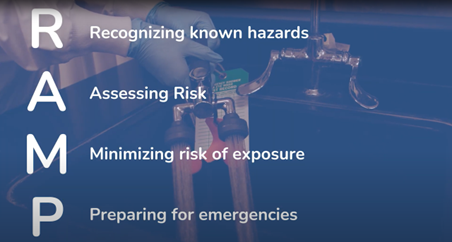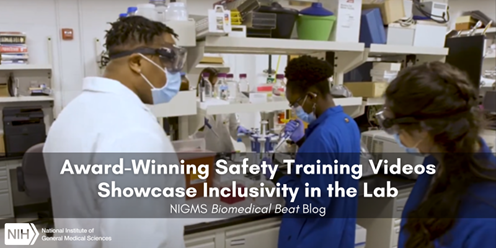Virginia Commonwealth University’s (VCU’s) Center on Health Disparities and safety and risk management department in Richmond teamed up to develop a series of six lab safety training videos with supplemental funding to their NIGMS-funded Initiative for Maximizing Student Development (IMSD) program. The videos cover topics such as safety culture, biosafety, chemical safety, and emergency response, but what sets them apart is how they showcase diversity and inclusion in the lab.
The first video in the safety training series describes the importance of maintaining positive safety culture, which includes people’s perceptions and attitudes toward safety. This video, along with the other five, is on our NIGMS laboratory safety training and guidelines webpage.
Lights, Camera, Action!
When Rita Shiang, Ph.D., a faculty member in the VCU Center on Health Disparities and the department of human and molecular genetics, learned about the funding opportunity from NIGMS to create lab safety videos demonstrating inclusivity in the lab, she jumped into action. The first step: getting Larry Mendoza on board as a subject matter expert. Mendoza is the laboratory safety officer at VCU in the safety and risk management department. He oversees all aspects of lab safety, including lab inspections and, importantly, lab safety training. “I knew that if Larry was on board, we had the potential to make a great set of videos,” Dr. Shiang says.
Luckily, Mendoza didn’t need convincing of the potential impact these videos could have to enhance lab safety training across the country. “This was a perfect opportunity for me. It combined a lot of topics that I really value—safety, representation, and inclusivity,” he says.

Together, Mendoza and Dr. Shiang brainstormed what scenarios to depict in the videos and then began to write the scripts. It was important to them that they wrote as realistic a script as possible, so they described real scientific techniques when showing proper lab safety. For example, they explained the need for hearing protection when using a sonicator, a machine that uses ultrasonic sound waves to disrupt cell membranes.
“We tried to make these feel like real scenarios. We filmed in real labs on campus and invited our students to be our actors. They brought a great research-oriented perspective to the development process,” Mendoza says.
Student involvement is one aspect that Dr. Shiang is most proud of about this project. “The people you see in these videos—they’re actually our student scientists. They’re the people who make up our labs, and to showcase them and highlight VCU as a leader in inclusivity was important to us,” she says.
The last piece of the puzzle fell into place when Mendoza and Dr. Shiang recruited VCU Online for Faculty, a video production office at VCU. They orchestrated the filming, recorded Mendoza speaking the narrations, and conducted postproduction editing to create the videos.
The videos are now available online for anyone to watch and use in their classrooms or labs.
Actors’ Insights and an Award

Lois Akinola, Ph.D., and Bryan McKiver, M.S., who were both a part of the NIGMS-funded IMSD program at VCU, are two of the researchers-turned-actors in the lab safety videos. Both wanted to be actors when they were kids, so the opportunity to get in front of the camera on a project that combined their love of science with their desire to promote inclusivity in the lab was one they couldn’t turn down.
“The goal behind the project really resonated with me,” Dr. Akinola says. “It was special to show future researchers what scientists look like, what they do in the lab, and how much fun they can have while working safely.”
Bryan is most proud of the project for its representation aspect. “You can see a collection of students from underrepresented minority groups in our videos. It’s so important that our viewers see that they can occupy these positions of graduate student, postdoctoral researcher, or principal investigator,” he says.
As a testament to their hard work, the Campus Safety, Health, and Environmental Management Association presented VCU with the 2023 Innovation Award for Safety Culture for a Large School. “I’m very proud that VCU is taking the lead on inclusivity in safety. I think being nationally recognized with this award shows that we’re doing something different, and we’re doing it right,” Mendoza says.
The VCU IMSD program was funded through NIGMS grant R25GM090084, currently through T32GM148403. The lab safety videos were funded by NIGMS supplement R25GM090084-11S1.
Other Posts You May Like
- Understanding Signaling Through Cell Membranes: Q&A With Chrystal Starbird
- Bil Clemons: Following Scientific Curiosity
- From Science Fair to Science Lab: Q&A With Chelsey Spriggs
- Haley Bridgewater: Taking the Sting Out of Vaccines
- Investigating the Inner Workings of Ion Channels With Sudha Chakrapani







